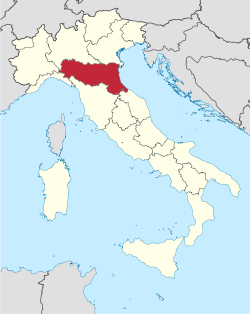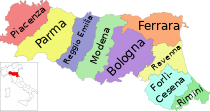艾米利亚-罗马涅大区
body.skin-minerva .mw-parser-output table.infobox captiontext-align:center
艾米利亚-罗马涅 Emilia-Romagna | |||
|---|---|---|---|
| |||
 | |||
坐标:44°45′N 11°00′E / 44.75°N 11°E / 44.75; 11 | |||
| 國家 | 意大利 | ||
| 首府 | 博洛尼亞 | ||
| 政府 | |||
| • 首腦 | Stefano Bonaccini (民主黨) | ||
| 面积 | |||
| • 总计 | 22,447 平方公里(8,667 平方英里) | ||
| 人口(2010-11-30) | |||
| • 總計 | 4,429,766 | ||
| • 密度 | 200/平方公里(510/平方英里) | ||
| 时区 | CET (UTC+1) | ||
| • 夏时制 | CEST(UTC+2) | ||
| GDP | €1387[1]億(2008) | ||
| 人均GDP | €31,900[2] (2008) | ||
| NUTS地區 | ITD | ||
| 網站 | www.regione.emilia-romagna.it | ||
艾米利亚-罗马涅(意大利語:Emilia-Romagna 發音:[eˈmiːlja roˈmaɲɲa],艾米利亞語:Emélia-Rumâgna)是位于意大利北部的大区,由历史上的两个大区艾米利亚和罗马涅组成。辖区形状如三角形,东临亚得里亚海,北界隔波河与伦巴第大区和威尼托大区毗邻,西临皮埃蒙特和利古里亚大区,托斯卡纳大区、马尔凯大区和圣马力诺共和国位于其南部。该区人口约4百万,人口密度为180人/平方公里。艾米利亚-罗马涅是意大利最发达的大区之一,亦是意大利著名的美食天堂。
大区首府博洛尼亚,是意大利重要的历史文化名城。其它城市有:帕尔马、皮亚琴察、雷焦·艾米利亚、摩德纳、里米尼、费拉拉、拉维纳等。
“艾米利亚-罗马涅” 的由来得益于其与古罗马的渊源。“艾米利亚”指艾米利亚大道──古罗马人修建的一条从罗马到意大利北部的古道;而“罗马涅”一词则是伦巴第人对拉维纳及其周边地区(包括今托斯卡纳和马尔凯的部分地区)的称呼。
目录
1 历史
2 经济
3 参考文献
4 外部链接
历史
古時屬伊特魯里亞文明一部分。古羅馬時代成為羅馬帝國一部分。中世紀出現世界上最古老的大學──博洛尼亞大學。19世紀意大利統一後,開始出現一些工業,包括多家著名跑車廠如法拉利、蘭博基尼等等。
经济
农业是该区最重要的经济来源,谷物、土豆、玉米、番茄和洋葱是其重要作物,而葡萄和其它水果的大量栽种使其成为意大利葡萄酒的主产区。另外畜牧业也十分发达。
工业也是该区的经济支柱,尤以食品加工业、机械、建築材料和汽车制造业为主。
参考文献
^ Eurostat - Tables, Graphs and Maps Interface (TGM) table. Epp.eurostat.ec.europa.eu. 2013-10-17 [2013-11-28].
^ EUROPA - Press Releases - Regional GDP per inhabitant in 2008 GDP per inhabitant ranged from 28% of the EU27 average in Severozapaden in Bulgaria to 343% in Inner London. Europa.eu. [2013-11-28].
外部链接
- 艾米利亚-罗马涅大区官方網站
| |||||||
| ||||||||||||||
|


